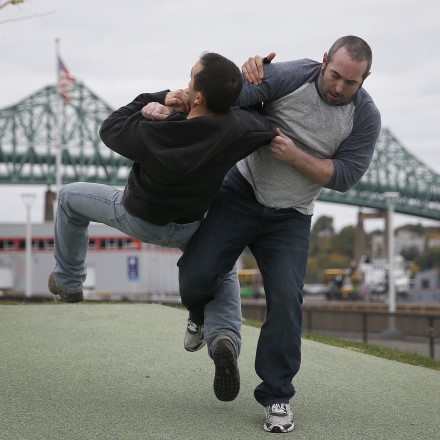Krav Maga Throwing

Throws & Takedown Articles
- The Art of Throwing
- The Usefulness Of Judo & Krav Maga
- Should Throws, Throwing & Takedowns Be Part of Krav Maga?
- Breaking Balance
- Leg Grabs For Judo & Self-Defense
- Disrupting Balance
- Don't Try To Throw Off A Punch
- Judo, Ippon-Seoi-Nage and Rear Strangles/Chokes
All Krav Maga Articles
Krav Maga's Use Of Throws & Takedowns
For many years Judo was taught alongside Krav Maga. One of the reasons for this was that in its early days Krav Maga was not recognized by the Wingate Institute as a martial art, outside of the military. In Israel every “sport” or “recreational” pursuit needs to be officially recognized by Wingate for an instructor to be able to teach civilians etc. As Krav Maga was not at the time when Imi Lichtenfeld left the IDF (Israeli Defense Forces) recognized as a system that could be taught to non-military, Imi needed to have Black Belt and an Instructor Certificate in a style that was recognized. Imi studied Judo under Guy Skolnick and became a Black Belt Judo instructor. This meant that his students studied Judo alongside Krav Maga, and that when they were tested for their Yellow Belt in Krav Maga, they were also tested in parallel for their Yellow Belt in Judo etc. This has meant that for much of Krav Maga’s early evolution, Judo became an influencing system. Whilst much of Krav Maga’s striking can trace its roots in Boxing, much of its grappling came from Judo and traditional Japanese Ju-Jitsu. This has been the case with much of the development of the IDF’s approach to unarmed combat, with the first manual of hand-to-hand combat being called “Judo Shimushi”, meaning “Useful Judo”.
All of the break-falls taught in Krav Maga come from Judo, and the throwing also. Judo and traditional Ju-Jitsu have a long history in the IDF, and the organizations such as the Haganah, which preceded it. KAPAP (an acronym for “Krav Panim A Panim”, meaning “fighting face to face” in Hebrew), was an approach to fighting which precedes Krav Maga was heavily influenced by Judo and incorporated many of its techniques. To be a complete fighting system, throws and takedowns, rather than just striking needs to be incorporated – even if this is just to allow students and practitioners an understanding of how such grappling systems work, in order to be able to counter and defend against them e.g., if an individual doesn’t know how a throw/takedown works then they will not have the knowledge, skills and abilities to be able to prevent themselves from becoming vulnerable to such attacks etc.
However, being able to utilize throws and takedowns is an important fighting skill, as throwing is a complementary skill to striking. For a strike, punch or kick to have maximum impact you require your assailant to be rooted, with all their weight loaded on their legs/feet so they absorb the full impact of the strike; if they are moving when they are hit then there is a possibility that much of the force of the strike will be translated into movement (this may be useful if they are walking onto the strike etc., but not if their movement is in any other direction). Where throws are concerned, the opposite is required i.e., you don’t want an individual to be rooted, but instead you want them moving and in motion, where balance-breaking becomes much easier to accomplish. This means that the two, striking and throwing, complement each other i.e., when somebody is rooted strike them, when somebody is moving throw them etc. Being skilled in both approaches means that an attacker will always be vulnerable.